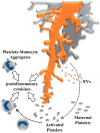Maternal Platelets—Friend or Foe of the Human Placenta?
- PMID: 31718032
- PMCID: PMC6888633
- DOI: 10.3390/ijms20225639
Maternal Platelets—Friend or Foe of the Human Placenta?
Abstract
Human pregnancy relies on hemochorial placentation, including implantation of the blastocyst and deep invasion of fetal trophoblast cells into maternal uterine blood vessels, enabling direct contact of maternal blood with placental villi. Hemochorial placentation requires fast and reliable hemostasis to guarantee survival of the mother, but also for the neonates. During human pregnancy, maternal platelet count decreases gradually from first, to second, and third trimester. In addition to hemodilution, accelerated platelet sequestration and consumption in the placental circulation may contribute to a decline of platelet count throughout gestation. Local stasis, turbulences, or damage of the syncytiotrophoblast layer can activate maternal platelets within the placental intervillous space and result in formation of fibrin-type fibrinoid. Perivillous fibrinoid is a regular constituent of the normal placenta which is considered to be an important regulator of intervillous hemodynamics, as well as having a role in shaping the developing villous trees. However, exaggerated activation of platelets at the maternal-fetal interface can provoke inflammasome activation in the placental trophoblast, and enhance formation of circulating platelet-monocyte aggregates, resulting in sterile inflammation of the placenta and a systemic inflammatory response in the mother. Hence, the degree of activation determines whether maternal platelets are a friend or foe of the human placenta. Exaggerated activation of maternal platelets can either directly cause or propagate the disease process in placenta-associated pregnancy pathologies, such as preeclampsia.
Keywords: placenta; platelets; preeclampsia; pregnancy.
Conflict of interest statement
The authors declare no competing interests.
Figures




References
-
- Benirschke K., Burton G.J., Baergen R.N. Pathology of the Human Placenta. 6th ed. Springer-Verlag; Berlin/Heidelberg, Germany: 2012.
Publication types
MeSH terms
Grants and funding
LinkOut - more resources
Full Text Sources

